
All Programs
- Switzerland Campus
School of Management
School of Computer Science
- Doctorate in Business Administration
Research Programs
- Bachelor of Business Administration
Bachelor's Programs

About EIMT
Student Zone
Switzerland Campus
About EIMT
Research
Student Zone
How to Apply
Apply Now
Request Info
Online Payment
Bank Transfer
Home / Online (PMP)® Certification Training Courses: How to Get a PMP Certification
MANAGEMENT
Oct 22, 2025
Getting a PMP feels like unlocking a career level — but it’s not magic. It’s a process: eligibility checks, focused training (the 35 contact hours), steady practice, a careful application, and disciplined exam prep. Below is a full, humanized, practical guide you can use as a roadmap, checklist, and study companion. This is a fairly comprehensive guide—it covers what most people look for first, then walks through the steps they’ll need to take next.
If you want the shortest path: confirm your eligibility, enroll in a PMI‑aligned online PMP certification training course that grants the required 35 contact hours, log your project hours in a spreadsheet, follow a time‑boxed study plan with lots of full‑length mocks, submit your PMI application, schedule the exam after approval, and keep audit documents ready. That’s the workflow in one sentence — the rest of this article fills in every detail.
The PMP (Project Management Professional) is PMI’s flagship credential that indicates you can lead projects in predictive, agile, and hybrid environments. Employers use it as a quick trust signal for leadership, governance, and delivery capability. For many, it leads to faster promotions, larger project scope, and measurable salary improvements. Think of PMP less as a certificate and more as a standardized shorthand for “I can run projects with discipline and outcomes.”
The current PMP exam is aligned with the PMBOK® Guide – Seventh Edition and the Agile Practice Guide, which means candidates are tested not only on predictive methods but also on agile and hybrid practices.
Globally, the PMP is recognized across industries — from IT and construction to healthcare, defense, and finance — with especially strong employer preference in the US, Middle East, India, and parts of Europe and Asia.
Read Also: PMBOK 8th Edition
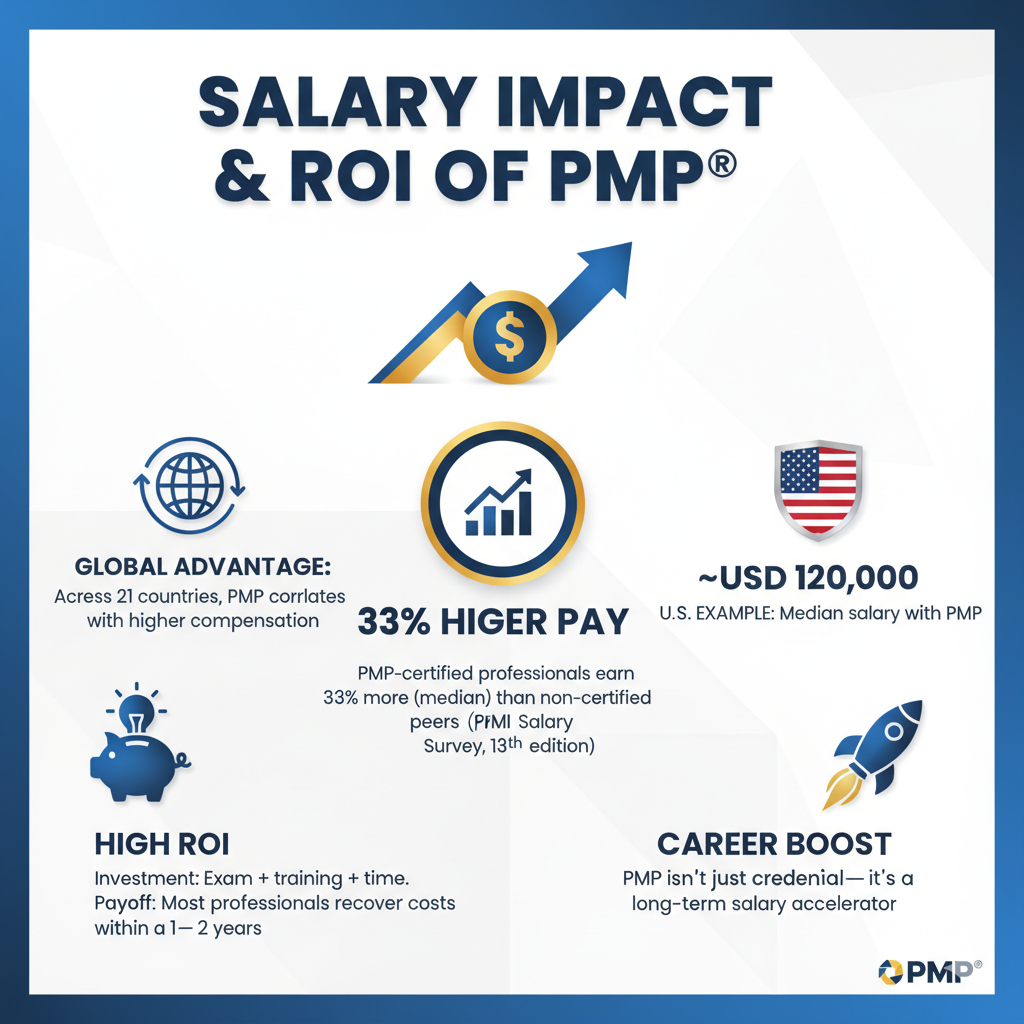
There are two main eligibility tracks:
Practical tip: start logging project hours now in a simple spreadsheet with columns: Project name; Employer; Role; Start/End dates; Total hours; Hours by process group; Short achievement line.
The PMP exam evaluates an individual's practical skills in three domains and not their experience with textbook information.
The majority of questions are presented as multi-faceted real-life scenarios with several acceptable responses or the use of judgment and trade-offs to achieve a business result. Questions involve the use of evidence-based communication, prioritizing stakeholders, and making escalation judgments in constrained contexts politically or with limited resources. Many will involve trade-offs between schedule vs. cost, quality vs. scope, short-term vs. long-term value. These tools such as earned value management or critical path analysis must be used in context – you will have to interpret their use and justify/ explain why one approach is preferred to another and not just provide a replication of a formula or memorized facts.
Recent PMI updates emphasize agile and hybrid project management, with roughly 50% of exam questions now drawn from agile or hybrid approaches and the rest from predictive practices.
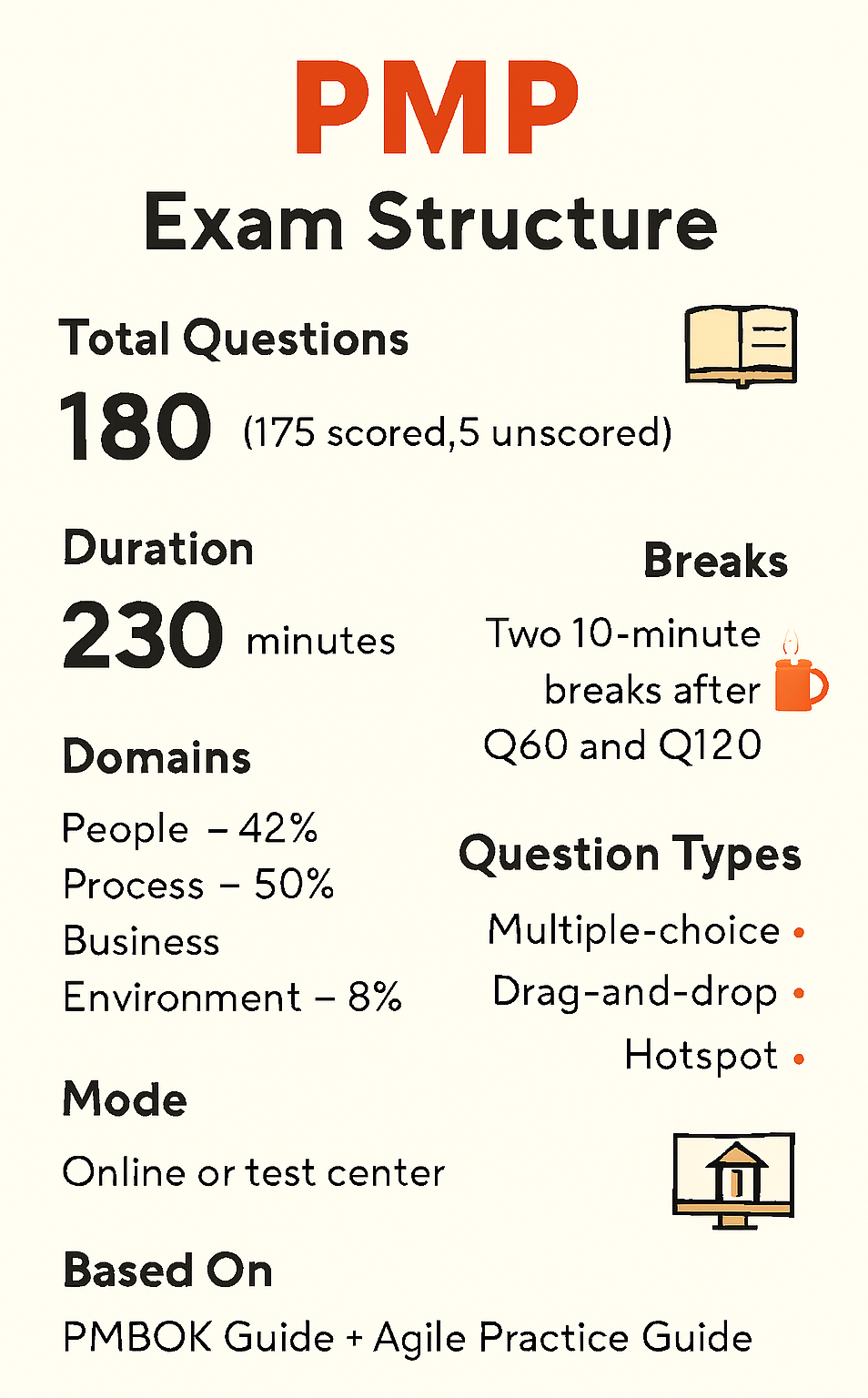
Practice suggestion: take at least five full 230‑minute mocks under test conditions before your exam date. Time management is the single biggest failure point for otherwise prepared candidates.
When scheduling your PMP® exam, you can choose between taking it online with a remote proctor or at a Pearson VUE test center. Both options are equally valid, but each has unique pros and cons depending on your preferences and environment.
Pros:
Cons:
Tips to Avoid Glitches:
Pros:
Cons:
If you value convenience and flexibility, online proctoring is attractive, but you must prepare for potential tech hiccups. If you prefer a controlled, distraction-free environment, the test center may give you more peace of mind.
What to prioritize when selecting a course for PMP certification training online:
Red flags:
Popular digital simulators and training platforms that candidates use include Careerera, PrepCast, PMTraining, and Simplilearn, which provide high-volume question banks and timed practice exams closely mirroring the real test.
|
Provider type |
What to expect |
Best if you want |
|
PMI authorized partners |
ECO‑aligned content, audit help, official materials |
Audit safety and strict alignment |
|
MOOC platforms |
University instructors, structured modules; sometimes include 35 hours |
Flexible pacing and academic depth |
|
Bootcamps |
Live intensive training, lots of mocks |
Time‑boxed, hands‑on coaching |
|
Question bank services |
Massive practice libraries, simulators |
High volume practice and exam simulation |
Sources for comparison: cross‑industry training landscape and candidate reviews.
Savings tips:
Practical setup: create a “study dashboard” with weekly targets, mock schedule, and a running error log that tags mistakes by type (knowledge gap, careless, timing).
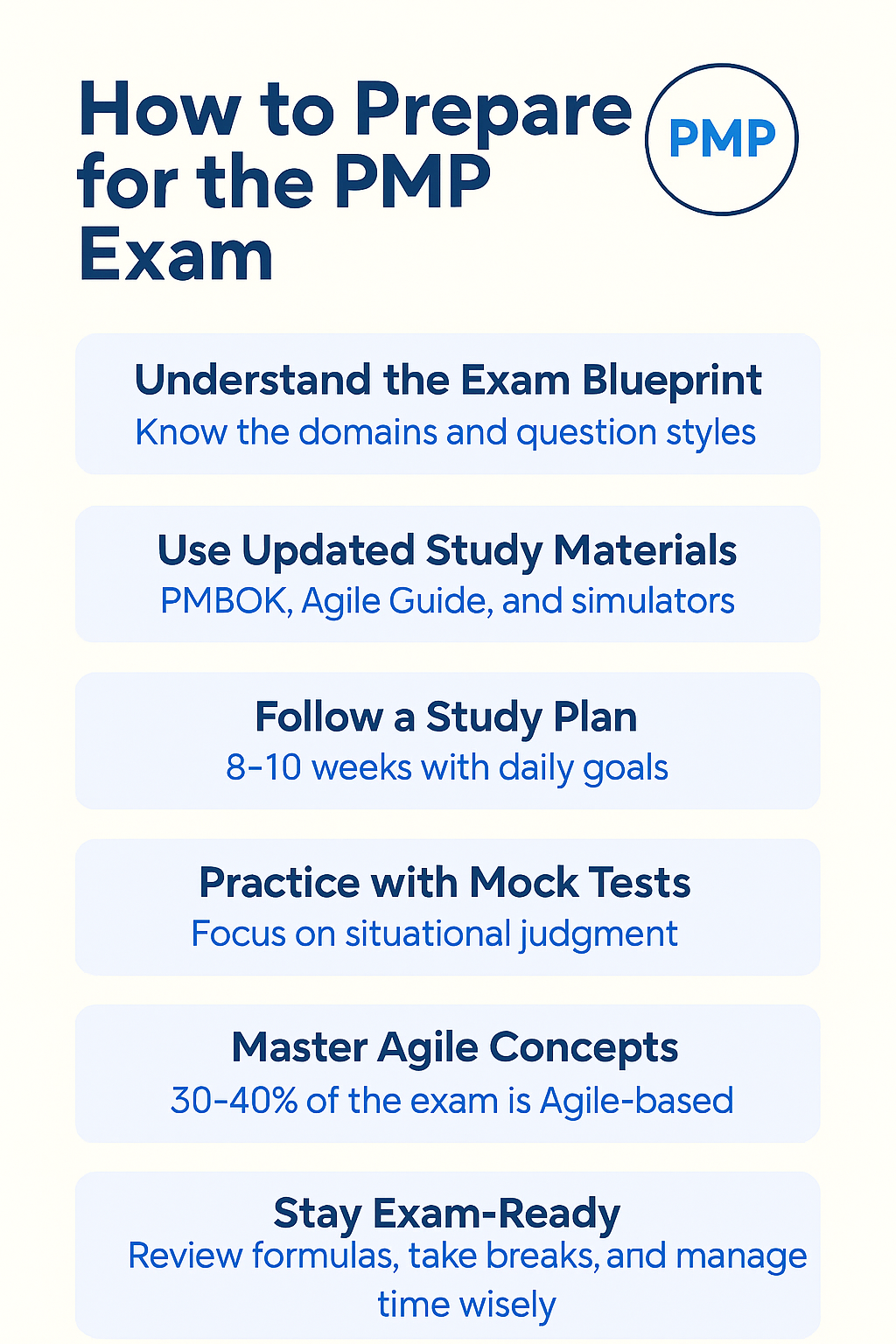
Offer both an 8‑week sprint and a fuller 12‑week plan so readers can match availability.
8‑week sprint (for focused learners)
12‑week full plan (recommended for working professionals)
Always log and review wrong answers: the analysis (why you missed it) is where the score improvements come from.
Choosing the right resources can make preparing for the PMP® exam much more effective. Below are some of the most trusted study materials that cover different learning styles and needs:
The official PMI resources. Together, they provide the foundation of PMP exam content, covering both predictive and agile approaches.
Widely considered the gold standard for PMP preparation. Rita’s book simplifies complex concepts, includes practice questions, and helps learners think the “PMI way.”
Ideal for visual learners. Its graphics, diagrams, and engaging explanations make project management principles easier to grasp and remember.
Mobile apps and digital flashcards are excellent for quick, daily review. Many candidates use them to reinforce key formulas, terms, and processes on the go.
Many learners search for “best PMP books,” and these resources consistently top the list, making them reliable starting points for anyone mapping out their study plan.
How to write project descriptions (samples you can adapt)
Tips:
This structure helps PMI assess the “leading” aspect of your work in case of an audit.
Keep this packet ready before submitting your application:
Timeline: if audited, you usually have 90 days to submit documents. Preparing in advance avoids panic.
Before test day
During the exam
After the exam
Immediate moves
Career roadmap
Small fixes: weekly mock + weekly review beats weekend cramming.
Getting your PMP® is a big achievement, but what you do afterward can really speed up your career growth. Here are a few simple steps to get the most out of your certification:
Meet other project managers in your area. These groups often run events, workshops, and meetups where you can learn and make valuable connections.
Write short articles, post on LinkedIn, or speak at webinars. Sharing tips and experiences makes you more visible and shows that you’re an expert in your field.
Help others who are studying for the PMP. Teaching not only supports others but also makes your own knowledge stronger.
By staying active, visible, and connected, you turn the PMP from just a certificate into a real career booster.
Many aspiring project managers wonder if PMP® is the right certification for them. Here’s a quick comparison of PMP with other popular certifications to help you decide:
|
Certification |
Focus Area |
Experience Required |
Exam Format |
Typical Benefits |
Best For |
|
PMP |
Broad project management (predictive & agile) |
3–5 years leading projects |
180 multiple-choice questions, 4 hours |
Higher salaries, global recognition |
Experienced PMs aiming for leadership roles |
|
PRINCE2 |
Process-driven project management |
None (Foundation); some experience for Practitioner |
Foundation & Practitioner exams |
Structured methodology knowledge |
PMs in Europe/UK or in government projects |
|
CSM (Certified ScrumMaster) |
Agile & Scrum framework |
None |
Online exam, multiple-choice |
Agile team management skills |
Team leads or agile practitioners |
|
PMI-ACP |
Agile project management across frameworks |
2,000 hours general PM + 1,500 hours agile |
120 multiple-choice questions |
Agile expertise, higher credibility |
PMs working in agile environments |
|
CAPM |
Entry-level PM knowledge |
None |
150 multiple-choice questions |
Intro to PM, PMI recognition |
Beginners starting a PM career |
Key Takeaway:
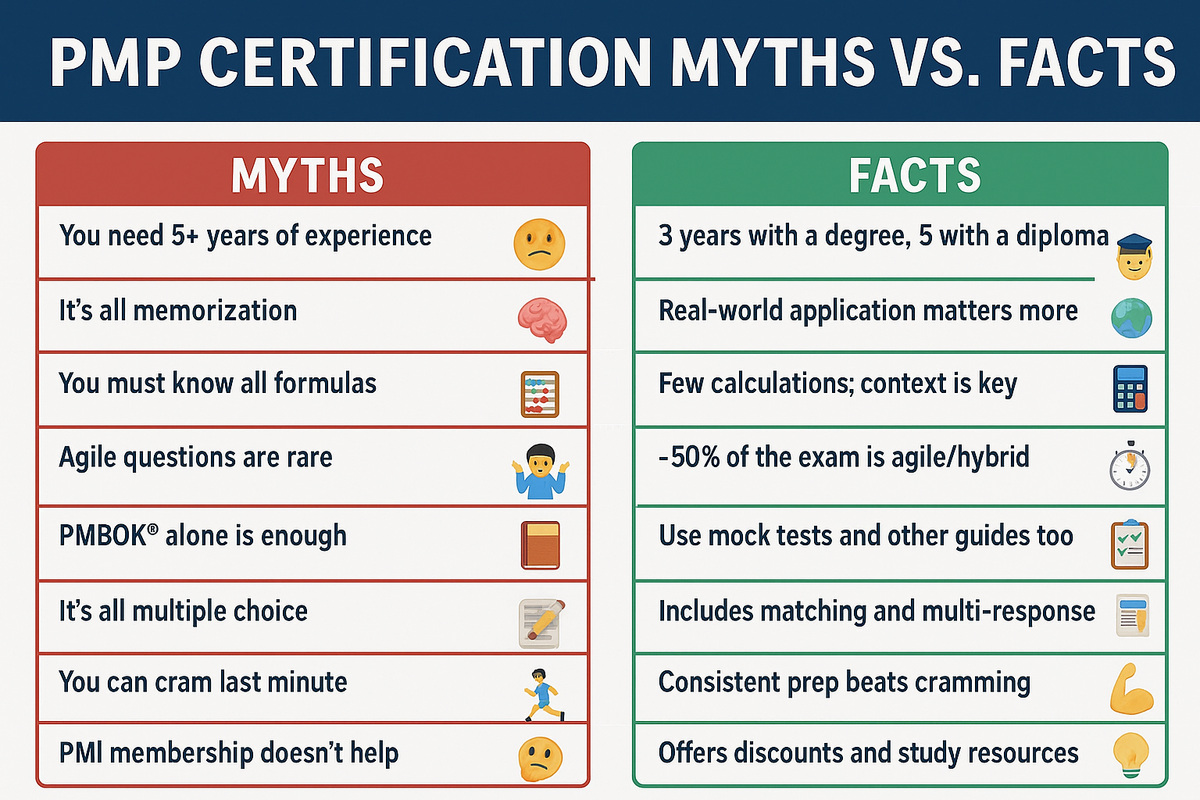
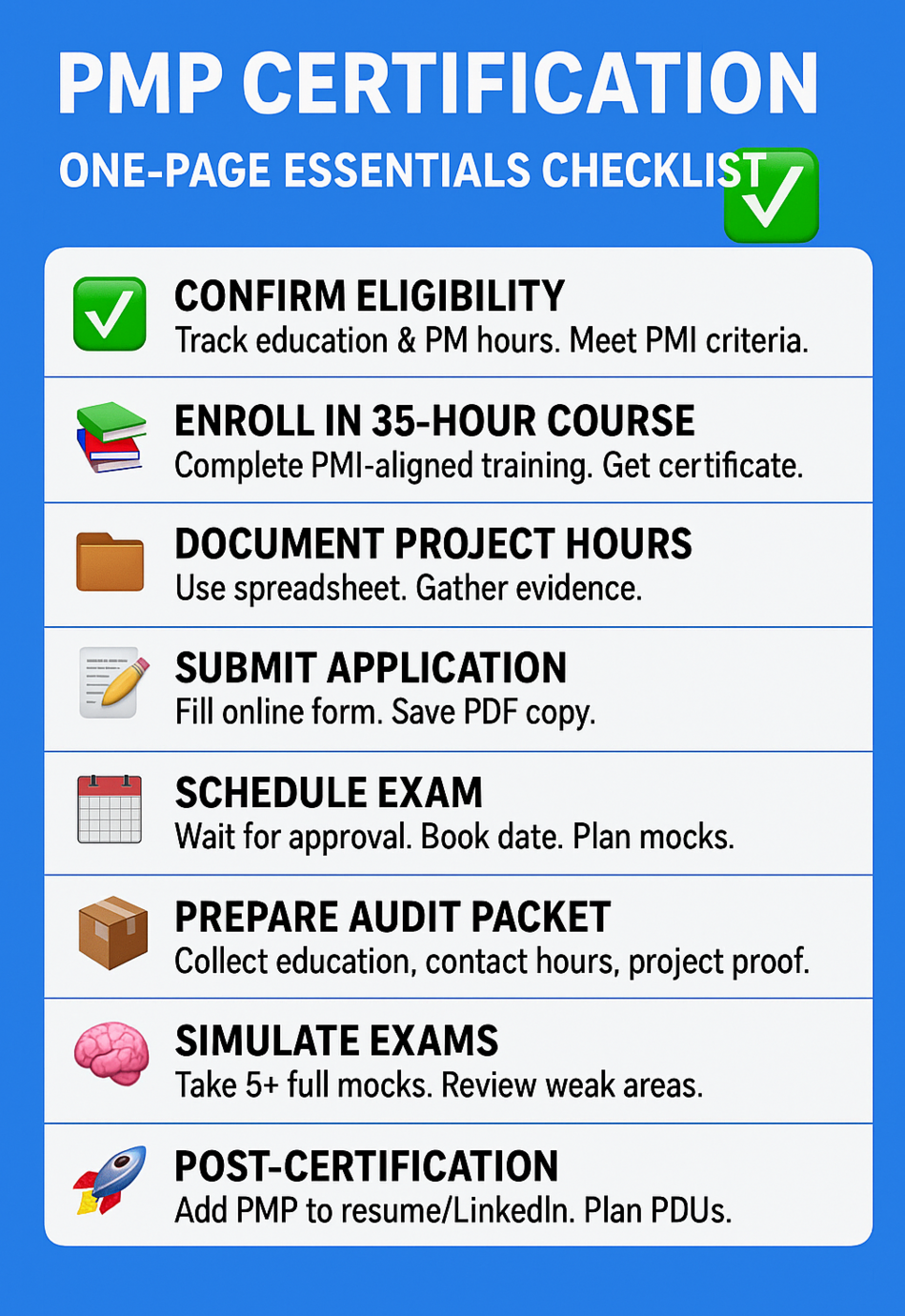
With this roadmap, you now have a clear path from confirming eligibility to exam day, audit preparation, and maintaining your PMP credential. The next step is to put the plan into action: organize your project hours, schedule study sessions, and employ the right tools to track your progress. Taking these concrete steps will keep you focused, ensure you meet PMI requirements, and set you up for a successful PMP certification journey. Your preparation today lays the foundation for career growth and recognition as a certified project management professional.
Yes. PMI offers an online proctored option you can take from home or office. Confirm system requirements (webcam, stable internet, compatible browser), set up a quiet, well‑lit workspace, and run the vendor’s system check ahead of time. Do a full‑length practice proctored session if the provider offers one so you know how breaks, camera checks, and proctor interventions feel.
You need 35 contact hours of formal project management education. These hours must be from an approved provider or a course that issues a verifiable certificate showing the course title, provider, date, and total hours. Self‑study without a formal certificate usually won’t count, so pick a course that explicitly states it provides the 35 required hours.
They can — but only when your role involves genuine leadership and direction of project work, not just facilitation. Emphasize where you made decisions, managed stakeholders, owned deliverables, or directed cross‑functional teams. Phrase entries to show leadership (e.g., “Led cross‑functional sprint planning and backlog prioritization impacting go‑live dates”) rather than merely “facilitated ceremonies.”
PDUs are Professional Development Units used to maintain your PMP. You must earn a set number of PDUs every three years (check PMI for the exact requirement at renewal time) through education (courses, webinars) and giving back (mentoring, volunteering, authoring). Track PDUs continuously in the PMI portal and prefer a mix of formal learning and practical contribution.
An audit asks you to submit proof of education, contact hours, and project experience. PMI typically gives a fixed window (commonly 90 days) to upload scanned documents: degree/diploma, 35‑hour course certificate, and project evidence (employer letters, project sign‑offs, or deliverable records). Prepare these before applying so an audit becomes administrative, not a crisis.
It depends on your background and availability. For working professionals, 10–12 weeks with consistent daily study (60–120 minutes) is common. If you can study full‑time, an intense 4–8 week sprint can work. The key is regular full‑length timed mocks and detailed review of mistakes; plan a buffer for a second attempt if needed.
If you don’t pass, PMI allows re‑attempts but there are rules and windows (check current PMI policy). Use PMI’s diagnostic feedback to identify weak domains, allocate targeted study time, and schedule a retake once you’ve closed the biggest gaps. Many candidates pass on the second attempt after focused remediation.
Membership is worth considering: it reduces your exam fee, gives access to digital PMI resources, and sometimes includes additional prep material. If you are already sure you’ll sit for the exam, joining before you pay often saves money overall. Factor membership cost into your budget and compare the net savings.
Yes. PMI values demonstrated leadership over methodology. Agile or hybrid project hours count if you led or directed project outcomes in those environments. Describe your role in context (e.g., “Led agile release planning across three teams, prioritized backlog to meet business goals”) and map hours to process groups where possible.
Employer sponsorship is common and very helpful. Ask for course fee support, paid study leave, access to internal project records for application proof, and paid exam fees or retake coverage. Also request time for mock exams during work hours and formal mentoring from senior PMs — practical workplace support improves both your readiness and the value your employer gets from your certification.
Stay Connected !! To check out what is happening at EIMT read our latest blogs and articles.